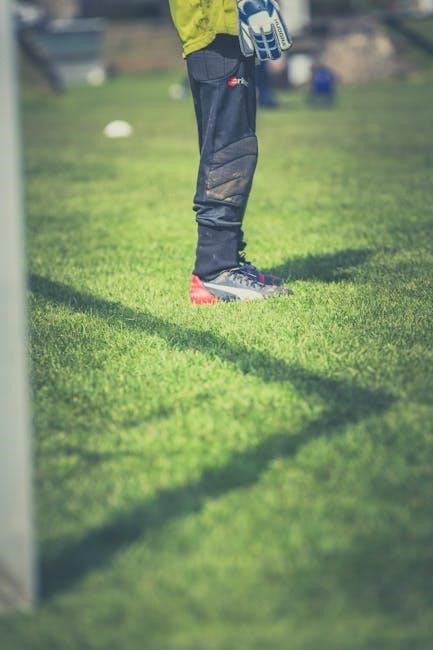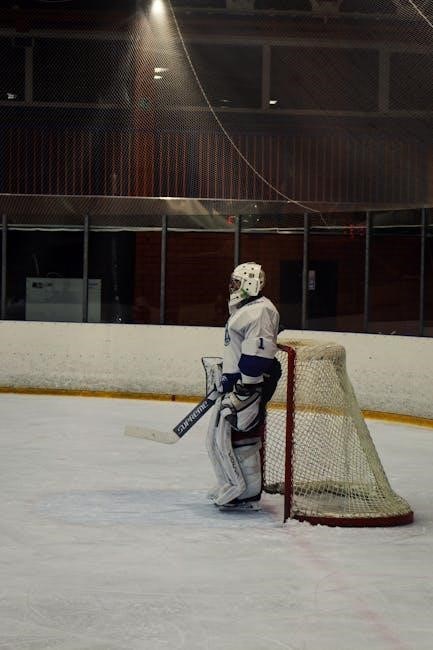Goalie Pad Sizing Guide: A Comprehensive Overview (Updated November 28, 2025)
Navigating goalie pad sizing requires understanding ATK measurements, NHL regulations, and how pad size impacts technique․ This guide provides detailed charts and considerations for optimal fit․
Understanding Goalie Pad Sizing Fundamentals
Proper goalie pad sizing isn’t simply about choosing a number; it’s a crucial element of performance and protection․ The foundation of accurate sizing relies on the Ankle-to-Knee (ATK) measurement, a standardized method for determining the appropriate pad length․ Understanding that NHL regulations have evolved, particularly with changes implemented in 2013-14 to address pad size and scoring, is vital․
These rule adjustments aimed to create a more level playing field and potentially increase goal scoring․ Goalie pad sizing directly influences a goaltender’s ability to execute techniques like the butterfly and hybrid styles․ Ill-fitting pads can severely restrict mobility and compromise coverage, impacting reaction time and overall effectiveness․ Therefore, a thorough grasp of these fundamentals is the first step towards selecting the ideal pads․
The Importance of Proper Pad Fit
A correctly fitted goalie pad is paramount for maximizing performance, preventing injury, and ensuring confidence on the ice․ Pads that are too large hinder agility and responsiveness, creating mobility issues that compromise a goalie’s ability to react quickly to shots․ Conversely, pads that are too small leave crucial areas exposed, increasing the risk of injury and reducing coverage․
Proper fit allows for efficient movement and precise positioning, enabling goaltenders to execute saves effectively․ It’s not merely about comfort; it’s about biomechanics and how the pads interact with the goalie’s skating and movements․ A well-fitted pad enhances control and provides the necessary protection without sacrificing performance, ultimately contributing to a goalie’s success․
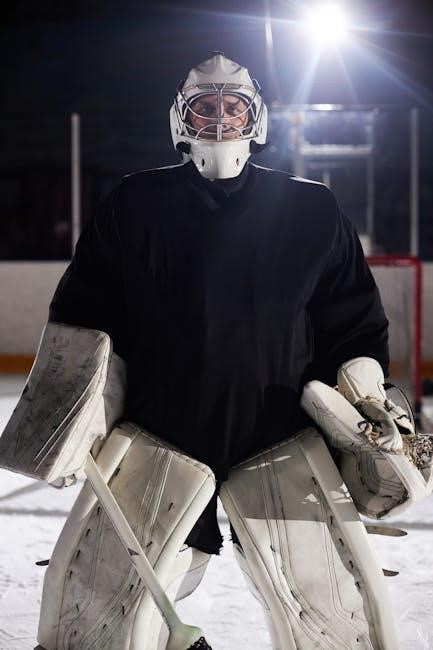
Key Measurements for Goalie Pad Selection
Accurate measurements are the foundation of selecting the right goalie pads․ Three primary measurements are crucial: Ankle to Knee (ATK), Shin Height, and Pad Width․ ATK, the standard measurement, determines the overall pad length․ Shin Height dictates the pad’s vertical coverage, ensuring adequate protection․ Pad Width impacts the goalie’s stance and butterfly position․
Precise measurements prevent common sizing errors․ A general rule suggests a 7 to 8-inch difference between ATK and pad size․ Skate size is also vital for boot fit compatibility․ Instep to knee measurement further refines the fit, ensuring optimal comfort and performance․ Utilizing these measurements guarantees a secure and effective pad fit․
Ankle to Knee (ATK) Measurement
The Ankle to Knee (ATK) measurement is the cornerstone of goalie pad sizing․ To obtain an accurate ATK, kneel with your back against a wall and measure from the center of your ankle bone to the center of your kneecap․ Ensure the leg is fully extended and the measurement is taken along the outside of the leg․
This measurement directly correlates to the pad’s length․ A typical guideline suggests subtracting 7 to 8 inches from your ATK measurement to determine the appropriate pad size․ However, individual preferences and playing style can influence this․ Accurate ATK measurement is vital for optimal coverage and mobility․
Shin Height Measurement
Shin height is a crucial secondary measurement for refining goalie pad selection․ Measure from the top of your skate boot (where the tongue ends) to the center of your kneecap while standing․ This measurement helps determine the appropriate pad profile and ensures adequate shin protection․
Shin height, combined with ATK, dictates the pad’s overall coverage․ It’s particularly important for goalies with longer or shorter legs relative to their overall height․ Comparing your shin height to sizing charts will help narrow down pad options and prevent gaps or excessive coverage․ Accurate shin height measurement contributes to a secure and comfortable fit․
Pad Width Measurement
Pad width is often overlooked, yet it significantly impacts a goalie’s stance and seal․ Measure around the widest part of your shin, typically a few inches below the kneecap, while wearing your game socks and shin guards․ This measurement ensures the pad isn’t too constricting or too loose, affecting mobility and responsiveness․
Proper pad width contributes to a strong butterfly seal and efficient side-to-side movement․ Refer to brand-specific sizing charts, as pad width varies between manufacturers․ A correctly sized pad width enhances control and prevents unwanted rotation, ultimately improving overall performance on the ice․
Youth Goalie Pad Sizing
Properly fitting youth goalie pads are crucial for developing technique and ensuring safety․ Growth spurts necessitate regular re-evaluation of sizing, as ill-fitting pads hinder performance and can cause discomfort․ Youth sizing differs significantly from senior models, focusing on shorter ATK measurements and narrower widths․
Utilize dedicated youth sizing charts, considering both imperial and metric measurements for accuracy․ Prioritize a snug, yet not restrictive, fit allowing for agile movements․ Remember that youth pads often have limited adjustability, making precise sizing even more important․ Consult with experienced hockey equipment retailers for personalized recommendations․
Sizing Charts for Youth Pads (Imperial)
Below is a representative imperial sizing chart for youth goalie pads; however, variations exist between brands․ Always consult the specific manufacturer’s chart for the most accurate fit․ Pad size is typically determined by shin height, ranging from 20” to 24”․
| Pad Size | Shin Height | Pad Width |
|---|---|---|
| S (20″) | 12․5″, 13․5″ | 7․75″ |
| M (22″) | 14″ — 15″ | 8․25″ |
| L (24″) | 15․5″ ⸺ 16․5″ | 8․75″ |
These are general guidelines; individual fit may vary․
Sizing Charts for Youth Pads (Metric)
Here’s a metric-based sizing chart for youth goalie pads, offering an alternative to imperial measurements․ Remember that brand-specific charts are crucial for precise sizing, as variations occur․ Shin height, measured in centimeters, is the primary factor, typically falling between 31․5cm and 34․5cm for youth sizes․
| Pad Size | Shin Height (cm) | Pad Width (cm) |
|---|---|---|
| S (20″) | 31․5 — 34․5 | 19․7 |
| M (22″) | 35․5 — 38․1 | 21․0 |
| L (24″) | 39․4 — 41․9 | 22․2 |
Always prioritize the manufacturer’s recommendations for the best fit․

Senior Goalie Pad Sizing
Senior goalie pad sizing centers around accurate measurements and understanding the nuances of different brands․ Unlike youth sizing, senior pads offer a wider range of sizes to accommodate varying leg lengths and builds․ The Ankle-to-Knee (ATK) measurement remains paramount, but skate size and instep-to-knee distance also play critical roles in achieving a secure and responsive fit․
Detailed sizing charts, both imperial and metric, are essential tools․ These charts typically correlate ATK measurements with corresponding pad sizes, ensuring optimal coverage and mobility․ Remember to consult brand-specific guides, as sizing can vary significantly․
Sizing Charts for Senior Pads (Imperial)
Below is a general imperial sizing chart for senior goalie pads, serving as a starting point for selection․ However, always prioritize brand-specific charts for the most accurate fit․ Pad size is typically determined by Ankle-to-Knee (ATK) measurement․
- ATK 20-22 inches: Pad Size 32-33 inches
- ATK 22-24 inches: Pad Size 34-35 inches
- ATK 24-26 inches: Pad Size 36-37 inches
- ATK 26-28 inches: Pad Size 38-39 inches
- ATK 28+ inches: Pad Size 40+ inches
Pad width also influences the fit; wider legs may require wider pad models․ Remember, these are guidelines, and individual preferences vary․
Sizing Charts for Senior Pads (Metric)
Here’s a general metric sizing chart for senior goalie pads, offering a convenient reference for international users․ As with imperial measurements, brand-specific charts are crucial for precise sizing․ The Ankle-to-Knee (ATK) measurement remains the primary factor in pad selection․
- ATK 50․8 — 55․9 cm: Pad Size 81․3 — 83․8 cm
- ATK 55․9 ⸺ 61 cm: Pad Size 86․4 — 88․9 cm
- ATK 61 — 66 cm: Pad Size 91․4 ⸺ 94 cm
- ATK 66 ⸺ 71․1 cm: Pad Size 96․5 — 99․1 cm
- ATK 71․1+ cm: Pad Size 101․6+ cm
Consider shin height alongside ATK for a comprehensive fit assessment․ Individual comfort and playing style should also influence your final choice․
NHL Goalie Pad Regulations & Changes
The NHL has a history of adjusting goalie pad regulations to promote scoring and maintain competitive balance․ Significant changes occurred in 2013-14, mandating a roughly 10% reduction in pad size․ Previously, pads could extend up to 20 inches above the knee; this was limited to nine inches․
Current regulations focus on limiting pad width and overall coverage․ Enforcement aims to prevent goalies from excessively blocking the net․ These rules are periodically reviewed, with ongoing discussions about further adjustments; Ryan Miller advocates for methodical changes, emphasizing careful consideration before altering equipment standards․
Historical Pad Size Restrictions (2013-14 Rule Changes)
Prior to the 2013-14 NHL season, goalie pads faced fewer restrictions, leading to concerns about diminished scoring․ Goalies could utilize pads extending up to 20 inches above the knee, significantly increasing net coverage․ The league responded with substantial rule changes aimed at reducing pad size and restoring offensive opportunities․
The key adjustment limited upper leg pad height to nine inches above the knee, a considerable reduction․ This change directly impacted pad sizing, forcing goalies to adapt to smaller equipment․ The intention was to decrease the area blocked by the pads, thereby increasing shot visibility and scoring chances․
Current NHL Pad Size Limits & Enforcement
Today, the NHL enforces strict regulations on goalie pad size to maintain a balance between goaltender protection and offensive play․ Upper leg pads are limited to a maximum of nine inches above the knee, a rule established following the 2013-14 changes․ This limit applies consistently across the league, aiming for uniformity․
Enforcement involves pre-game equipment checks and ongoing monitoring․ Officials verify pad compliance, ensuring goalies adhere to the size restrictions․ Any violation can result in penalties or required equipment adjustments․ The league prioritizes consistent application of these rules to prevent competitive advantages gained through oversized padding․
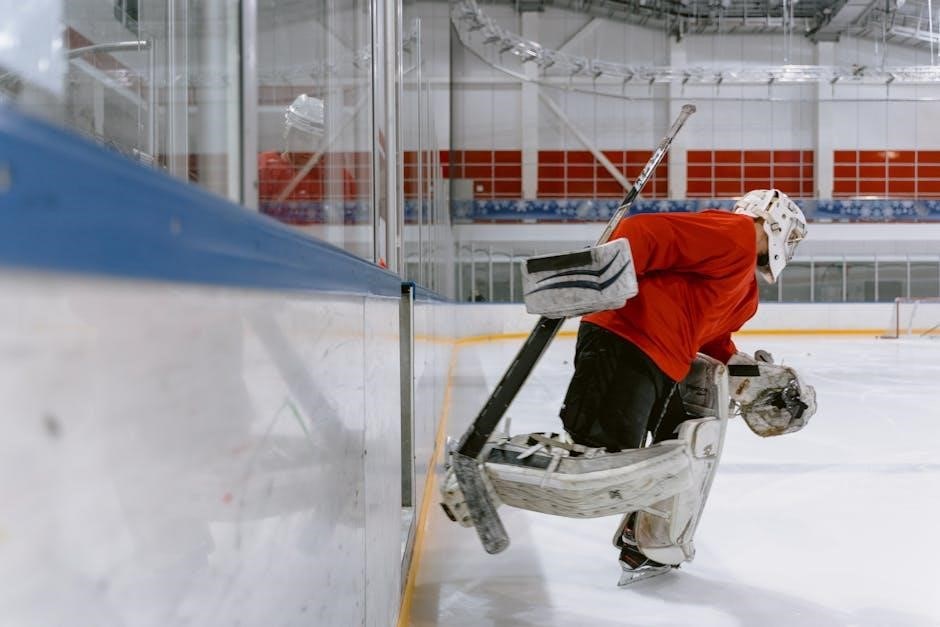
Impact of Pad Size on Goaltending Style
Pad size significantly influences a goaltender’s technique and overall style of play․ Larger pads generally favor a butterfly technique, providing extensive coverage and stability in the crease․ This style relies on sealing gaps and utilizing the pads’ surface area for rebounds control․
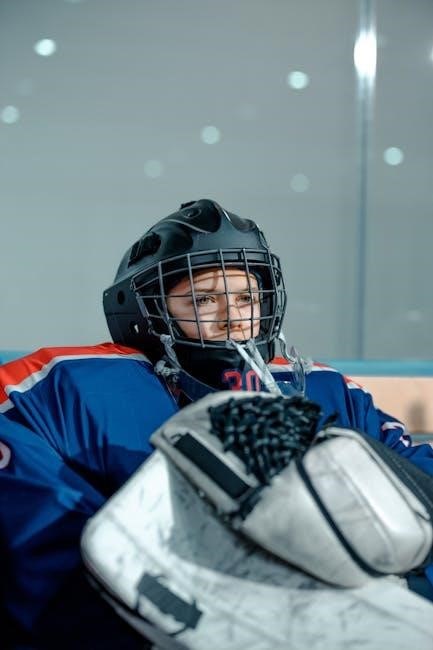
Conversely, smaller pads often complement a hybrid technique, emphasizing agility and quicker movements․ Goalies opting for this style prioritize responsiveness and the ability to track the puck efficiently․ The choice between pad size and technique is a personal one, dependent on strengths, weaknesses, and preferred play style․
Pad Size and Butterfly Technique
The butterfly technique thrives on maximizing coverage, making larger pads a common choice․ These pads effectively seal the five-hole and lower portions of the net, limiting scoring opportunities․ A wider profile provides a substantial barrier against shots, enhancing rebound control and reducing net-front traffic․
However, oversized pads can hinder mobility, potentially slowing down lateral movements․ Goalies employing the butterfly must balance coverage with agility․ Proper fit is crucial; pads shouldn’t restrict flexibility․ The ideal pad size allows for quick transitions between posts while maintaining a secure, sealed position․
Pad Size and Hybrid Technique
The hybrid technique demands versatility, blending elements of both butterfly and stand-up styles․ Goalies utilizing this approach often favor moderately sized pads, prioritizing maneuverability alongside adequate coverage․ A balance is key – pads shouldn’t be overly bulky, hindering quick movements or active stick work․
Hybrid goalies rely on responsiveness and the ability to quickly change angles․ Slightly smaller pads can facilitate faster lateral pushes and recoveries․ While full coverage remains important, the emphasis shifts towards agility and the capacity to track the puck effectively across the crease․ Finding the right size supports a dynamic, adaptable game․
Determining Your Ideal Pad Size
Pinpointing your ideal pad size isn’t solely about ATK; it’s a holistic assessment․ Consider your skate size for a secure boot fit, as this directly influences pad positioning and comfort․ Measure from your instep to your knee – this instep-to-knee measurement refines sizing, accounting for individual leg proportions․
Don’t rely on a single chart․ Brand sizing varies, so consult specific guides․ A general rule suggests a 7-to-8 inch difference between ATK and pad size, but this is a starting point․ Prioritize a snug, yet mobile fit․ Remember, proper sizing enhances performance and prevents injury, ensuring confidence on the ice․
Considering Skate Size for Boot Fit
Skate size is paramount when selecting goalie pads, directly impacting the overall fit and performance․ A properly fitted skate provides a stable base, influencing how the pad interacts with the ice and your movements․ The pad’s boot fit must be snug, preventing slippage during dynamic saves․
Provide your skate size when seeking sizing advice; it’s a crucial data point for retailers and brand-specific charts․ Ill-fitting skates compromise control and responsiveness․ Ensure adequate ankle support and minimal heel lift․ A secure skate-pad connection translates to enhanced agility and confidence, allowing for quicker reactions․
Instep to Knee Measurement
The instep to knee measurement is a critical component of accurate goalie pad sizing, complementing the ATK measurement․ This measurement, taken from the instep (top of the foot) to the center of the knee, determines the appropriate pad length for optimal coverage and protection․ It ensures the pad extends high enough to shield the knee without hindering flexibility․
Accurately measure this distance while standing with a slight bend in the knee․ This measurement, alongside skate size, helps refine pad selection, particularly when navigating brand-specific sizing variations․ A precise instep-to-knee measurement minimizes gaps and maximizes protection during various goaltending stances․
Common Goalie Pad Sizing Mistakes
Incorrect pad sizing significantly impacts a goalie’s performance and safety․ A frequent error is selecting pads that are too large, leading to restricted mobility and slower reaction times․ Excessive bulk hinders butterfly slides and overall agility, compromising the ability to track the puck effectively․ Conversely, pads that are too small offer insufficient coverage, increasing the risk of injury from shots․
Prioritizing aesthetics over fit is another common mistake․ Pads should never be chosen based solely on appearance․ Proper fit ensures optimal protection and allows for a full range of motion․ Always prioritize accurate measurements and consider the impact on goaltending style․
Pads That Are Too Big: Mobility Issues
Oversized goalie pads severely restrict a goaltender’s agility and responsiveness․ The added bulk impedes quick lateral movements, making it difficult to efficiently transition between positions․ Butterfly slides become labored and less explosive, hindering the ability to seal post holes effectively․ Excessive padding also diminishes a goalie’s feel for the puck, impacting rebound control․
Furthermore, larger pads can disrupt balance and coordination․ The increased weight and altered center of gravity require greater effort to maintain stability, leading to fatigue․ This ultimately compromises reaction time and overall performance, making it harder to react to quick shots․
Pads That Are Too Small: Coverage Concerns
Insufficiently sized goalie pads leave significant gaps in coverage, exposing vulnerable areas to shots․ Reduced protection increases the risk of injury from puck impact, particularly on the legs and knees․ Smaller pads offer less surface area to deflect shots, leading to more rebounds and potential scoring opportunities for opponents․
Inadequate pad size also compromises a goalie’s confidence and mental game․ The feeling of being exposed can create hesitation and affect reaction time․ Proper coverage is crucial for a goaltender to feel secure and perform at their best, minimizing anxiety during high-pressure situations․
Brand-Specific Sizing Guides (Example: True Goalie)
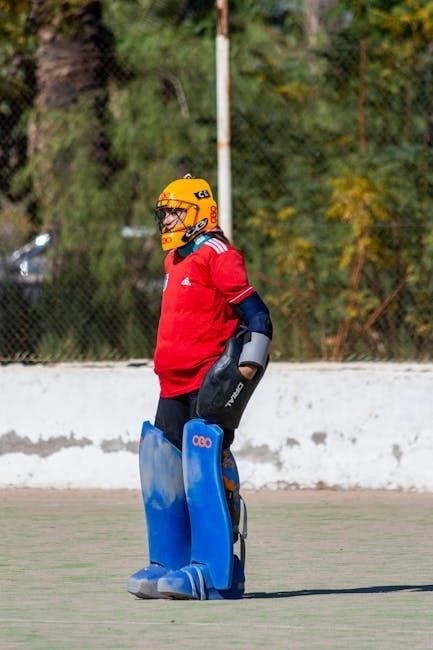
Each goalie equipment manufacturer often has unique sizing nuances․ True Goalie, for instance, provides detailed sizing charts encompassing shin height and pad width measurements․ These charts are crucial, as True pads may fit differently compared to Bauer or CCM․ Accessing True’s specific guide ensures accurate sizing based on their construction and design․
True’s resources include comprehensive tables for both youth and senior goaltenders, offering imperial and metric conversions․ They emphasize the importance of instep-to-knee measurements alongside ATK for a precise fit․ Utilizing brand-specific guides minimizes guesswork and increases the likelihood of selecting the optimal pad size for peak performance․
Understanding Pad Break-In and Adjustment
New goalie pads rarely offer a perfect fit immediately; a break-in period is essential․ Stiffness initially restricts mobility, but repeated on-ice use gradually molds the pads to the goaltender’s leg shape․ Heat molding, a process some retailers offer, accelerates this adaptation․
Adjustments are often necessary even after break-in․ Straps play a vital role in securing the pad and customizing the fit․ Proper strap configuration ensures optimal coverage and prevents unwanted movement during gameplay․ Regularly check and readjust straps to maintain a secure and comfortable feel, maximizing performance and protection․
Where to Find Reliable Sizing Charts
Accurate sizing begins with consulting reputable sources․ Manufacturer websites, like True Goalie, provide brand-specific charts detailing measurements for their equipment․ Retailers specializing in goalie gear, such as those offering professional fitting services, often host comprehensive sizing guides․
Beware of generic charts, as variations exist between brands and models․ Online resources compiling multiple brand charts can be helpful, but always cross-reference with the manufacturer’s official documentation․ Prioritize charts displaying both Imperial and Metric units for broader accessibility and ensure the date is current, reflecting recent model updates․
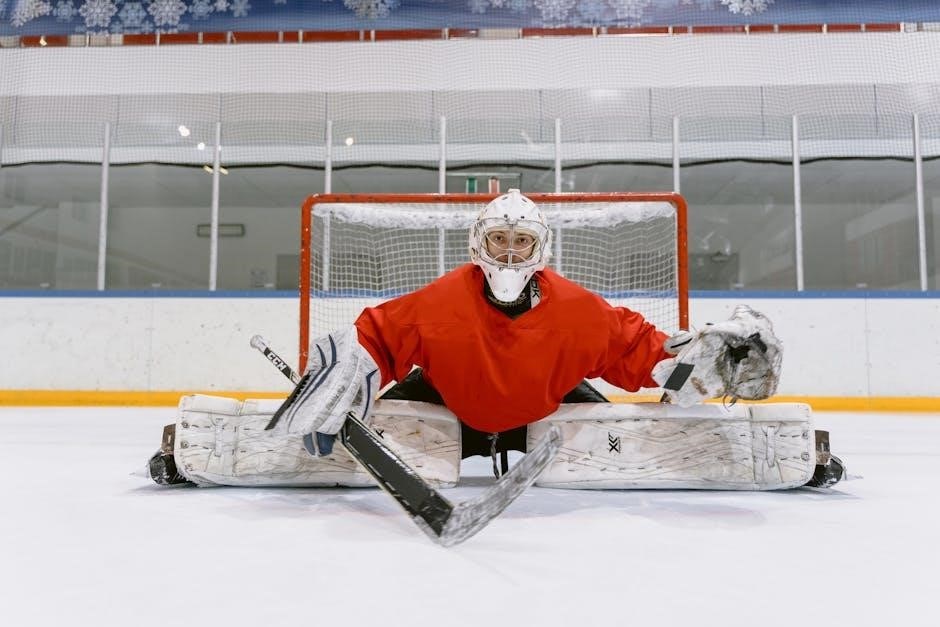
Professional Goalie Fitting Services
Investing in a professional fitting is invaluable, especially for developing goalies or those experiencing fit issues․ Experienced fitters assess ATK, shin height, and instep-to-knee measurements with precision, considering your skating style and skill level․
They can identify subtle nuances that online charts miss, ensuring optimal protection and mobility․ A fitter will also advise on appropriate pad profiles and break-in methods․ While potentially incurring a cost, a proper fit minimizes performance limitations and prevents discomfort or injury․ Seek out specialized hockey retailers or goalie-focused pro shops offering these services․
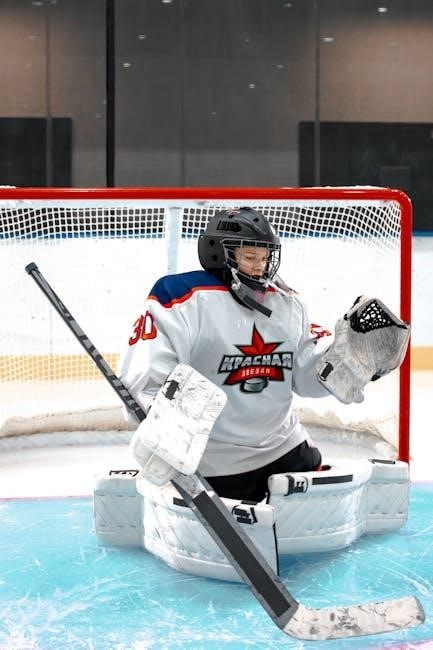
Resources for Further Research
Expanding your knowledge beyond this guide is crucial․ Numerous online resources offer detailed sizing charts from various brands like True Goalie, providing specific measurements for their equipment․ Websites dedicated to hockey equipment reviews often feature in-depth discussions on pad sizing and fit․
Stay informed about NHL rule changes impacting pad dimensions, as these can influence sizing recommendations․ Forums and online communities dedicated to goaltending provide valuable insights from experienced goalies and professionals․ Remember to cross-reference information and prioritize professional fitting services for personalized guidance․
